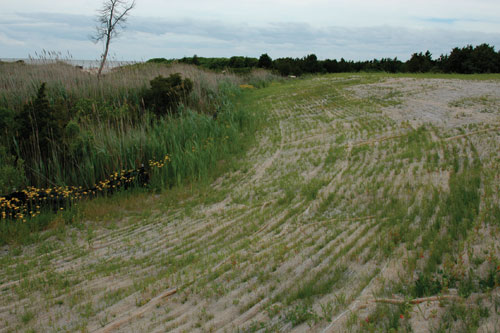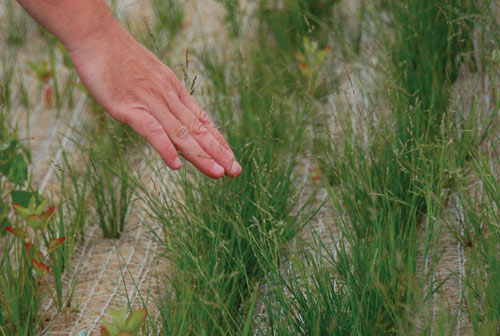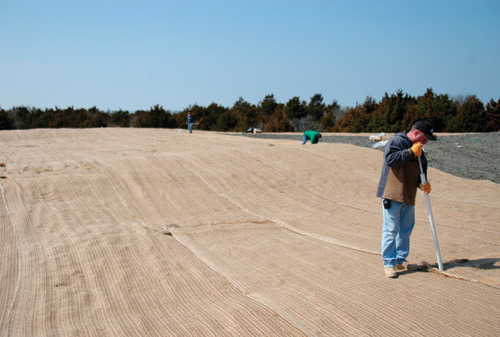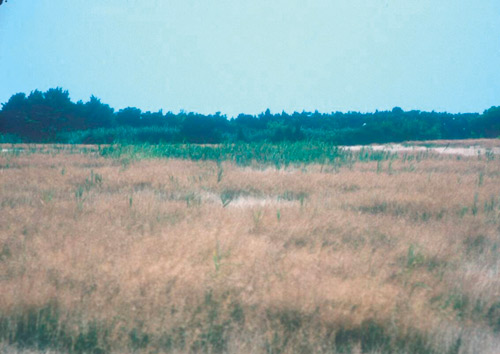| 
Germination of grasses in Phase II seeding.
Introduction
On September 17th, 1999, the land known locally as the “Magnesite Property,” comprising approximately 125 acres of undeveloped beach front, dune, coastal wetlands and a disturbed, former industrial area, came into the public domain as open space through the efforts of the New Jersey Green Acres Program. This property represents a significant addition to the existing Higbee Beach Wildlife Management Area and to Cape May Point State Park which are world renowned birding sites. No place in North America tallies greater numbers of osprey, peregrine falcon, merlin, and hawks during migration in the spring and fall. In addition, the diverse habitats on the fringes of this property supports two endangered species each of birds and plants. The piping plover and the least tern use this site for nesting. The endangered plant species found are the drummond’s rock cress and coast bedstraw.
Site Description
From 1941 to 1983, Dresser Industries operated the Harbison Walker - Cape May Works, also known as the Northwest Magnesite Plant. Operations at the plant consisted of reacting softened, clarified sea water from Delaware Bay with limestone to produce a magnesium hydroxide solution. This solution was filtered and then fired in rotary kilns to produce magnesite refractory brick. The brick was used to line steel factory furnaces which were especially important during WWII. The factory closed in 1983 and was demolished. Environmental contamination was cleaned up by Dresser Industries pursuant to the Environmental Cleanup Responsibility Act (ECRA). The only remains of the plant are a 10' chain link fence surrounding the plant site, a water tower, and scars on the landscape including a “landfill” of industrial waste consisting primarily of magnesite (magnesium carbonate) and limestone. The alkalinity (high pH) of the waste is high enough to prevent the establishment of native vegetation. The site has remained relatively unvegetated since the plant closure in 1983. The only vegetation volunteering on the waste magnesite material was a native alkali saltgrass (Puccinellia spp.) growing only in moist depressions.
A plan to restore native vegetation to the scarred industrial portion of the property was developed by the USDA-NRCS, Cape May Plant Materials Center and the Plant Materials Specialist in cooperation with the NJ Department of Environmental Protection. This site presented challenges from both a revegetation and an ecological restoration standpoint. Being in the path of the major Atlantic flyway, this area is used by neotropical migrants and raptors as well as supports a few rare plants and animals. Vegetating the area will require creating a soil which will support native vegetation. The waste magnesite has an absence of organic matter and is high in pH (7.9-9.9), which supports little natural vegetative growth. Initial plantings of American beachgrass, (Ammophila breveligulata), saltmeadow cordgrass (Spartina patens), and coastal panicgrass (Panicum amarum var. amarulum) directly into the magnesite material was not successful. Consequently, the final restoration plan involved amending the alkaline magnesite with incorporated dredge material. The source of this dredge material was the Cape May Canal Dredge Disposal facility. The dredge was spread about one foot thick and incorporated into the magnesite substrate with a dozer blade turned on edge. This process added some needed organic matter to support a beneficial microbial population to the magnesite and will hopefully lower the pH of the “soil” over time through oxidation. However, initially the dredge material had an alkaline pH (8.1) and contained a high level of soluble salts (4.6 mmhos/cm). Any recommended plants would have to tolerate the initial high pH and high soluble salts.

Closeup of alkali saltgrass plants.
Phase I Native Grass Seed Planting
The initial planting involved seeding the native cool/warm season grass and forb mixture on 9.3 acres. This was done January 11-12, 2001 as a winter dormant seeding. This seed mixture was designed to provide both short term and long term cover and to tolerate the varying soil pH’s and salinities as the soil conditions change over time:
• Alkali saltgrass (Puccinellia distans) - 20 #/ac
• Switchgrass (Panicum virgatum) - 10 #/ac.
• Annual ryegrass (Lolium multiflorum) - 10 #/ac.
• Canada wildrye (Elymus canadensis) - 5 #/ac.
• Redtop (Agrostis gigantea) - 1 #/ac.
• Little bluestem (Schizachyrium scoparium) - 5 #/ac.
• Round-headed bushclover (Lespedeza capitata) - 2 #/ac.
• Partridge pea (Chamaecrista fasciculata) - 2 #/ac.
TOTAL – 55 #/ac.
| Phase I - Seed mixture components
Quick establishing, short-lived
Redtop; perennial, introduced cool season (short persistence)
Alkali saltgrass; perennial, native, cool season grass (intermediate persistence)
Annual ryegrass; annual, introduced, cool season grass (short term persistence)
Canada wildrye; perennial, native, cool season grass (intermediate persistence)
Partridge pea; annua,l reseeding native legume
Slow establishing, long-lived
Switchgrass; perennial, native warm season grass
Little bluestem; perennial, native warm season grass
Round-headed bushclover; perennial, native warm season legume
|

Coir fiber blanket used to cover Phase II seeding.
A total of 55 pounds/acre of seed was applied by applying the seed in perpendicular directions with a Brillion drop seeder. The alkaligrass (Puccinellia distans), annual ryegrass (Lolium multiflorum), redtop (Agrostis gigantea) and Canada wildrye (Elymus canadensis) are cool season grasses designed to germinate quickly and tolerate the high salinity levels present in the dredge material. The native warm season grasses, switchgrass (Panicum virgatum) and little bluestem (Schizachyrium scoparium), are intended to provide long term stabilization and cover. The roundheaded bushclover (Lespedeza capitata) and partridge pea (Chamaecrista fasciculata) are native legumes added to the mix for species diversity. After seeding, the site was covered with an Excelsior erosion control blanket to prevent seed desiccation and wind movement.
Initial results
Plant establishment during the first growing season was encouraging. As expected, the alkali saltgrass, annual ryegrass and redtop dominated the site in the first growing season with a small percentage of Canada wildrye seedlings present. In the second growing season, alkali saltgrass and redtop remained dominant, but more seedlings of Canada wildrye and switchgrass were developing. Even a few switchgrass plants were flowering and producing seed under these difficult soil conditions. Unfortunately, no seedlings of little bluestem, partridge pea, or roundheaded bushclover have been observed to date. This is particularly surprising for partridge pea which is an annual legume. This lack of seedling development could be due to heavy cool season grass competition and/or the high soil salinity.
The newly established vegetation has provided the microclimate for volunteer native plants such as seaside goldenrod (Solidago sempervirens) and groundsel bush (Baccharis halimifolia) to establish. Unfortunately, the dredged material contained phragmites (Phragmites communis) rootstock and is also volunteering on the site. The spread of this invasive plant will be closely monitored.

Phase I seeding results.
Phase II Site Preparation/Seeding
Unlike the initial site preparation where the dredge was incorporated into the magnescite material, Phase II involved adding 4-8 feet of dredge material on top of the magnescite substrate to create an undulating dune-like topography. This would allow for a diversity of plant communities from moist to dry tolerant plant communities.
Phase II involved seeding an additional 14 acres in March 2005. Based on past results, the seed mixture has been altered to accommodate ease of seeding and adaptability of the species to the site conditions. We eliminated little bluestem from this seed mixture based on its lack of performance in the initial seeding and added deertongue (Dichanthelium clandestinum) and coastal panicgrass (Panicum amarulum var amaululum). Coastal panicgrass was added because of its tolerant of alkaline soils and nativity to this coastal ecosystem. Deertongue will be adapted to lower pH’s resulting from the oxidation of the dredge material. Also, lowering the rates of alkali saltgrass and annual ryegrass (from the original seeding) will reduce cool season competition for the native grasses and help achieve more balance and diversity in the stand. Also, the seeding rate of Canada wildrye was increased to 10 #/ac. based upon its good initial performance. The site was seeded with a Great Plains native grass drill to the following mixture:
• Alkali saltgrass (Puccinellia distans) – 2 #/ac
• Switchgrass (Panicum virgatum) – 3 #/ac.
• Coastal Panicgrass (Panicum amarulum) – 5 #/ac.
• Deertongue (Dichanthelium clandestinium) – 5 #/ac.
• Canada wildrye (Elymus canadensis) – 10 #/ac.
• Redtop (Agrostis gigantea) – 0.5 #/ac.
• Evening Primrose (Onethera biennis) – 5 #/ac.
• Partridge pea (Chamaecrista fasciculata) – 4 #/ac.
TOTAL – 34.5 #/ac.
| Phase II – Seed Mixture Components
Quick establishing, short-lived
Redtop; perennial, introduced, cool season grass (short persistence)
Alkali saltgrass; perennial, native, cool season grass (intermediate persistence)
Canada wildrye; perennial, native, cool season grass (intermediate persistence)
Partridge pea; annual reseeding, native legume
Slow establishing, long-lived
Switchgrass; perennial, native, warm season grass
Coastal panicgrass; perennial, native, warm season grass
Deertongue; perennial, native, warm season grass
Evening primrose; biennial, native, coastal wildflower
|
After the seeding operation, the area was covered with a 100% coir fiber blanket to protect the seeding from the harsh winds prevalent at the site.
Summary
This project highlights a beneficial use of dredge material. Adding organic matter to the magnesite substrate through dredge material incorporation appeared to provide a suitable medium for plant establishment and growth. Follow-up soil tests will provide indications on how quickly soil pH’s and salinities are changing. This will help plan future seeding recommendations. The success of this effort and the revegetation technologies demonstrated will serve to provide a technical framework for future coastal grassland habitat restoration projects. 
For more information contact Christopher Miller, Plant Materials Specialist, the Principal author, USDA-NRCS, Cape May Plant Materials Center, 1536 Route 9 North, Cape May Court House, NJ 08210, E-mail: chris.miller@nj.usda.gov, William Skaradek, Manager, USDA-NRCS, Cape May Plant Materials Center, 1536 Rt. 9 North, Cape May Courthouse, NJ 08210 or State of New Jersey, Dept. of Environmental Protection, Division of Engineering and Construction, Bureau of Coastal Engineering, 1510 Hooper Ave., Tom’s River, NJ 08753.
References
Vogel, Willis. 1987. A Manual for Training Reclamation Inspectors in the Fundamentals of Soils and Revegetation. USDA-Forest Service, Northeastern Forest Experiment Station
Barnheisel, R.,2000. Reclamation of Drastically Disturbed Sites. American Society of Agronomy. Monograph 46.
NJ Department of Environmental Protection- Bureau of Coastal Engineering.March 2000. “Maintenance Dredging of the Middle Thorofare Commercial Lagoon, Lower Township, Cape May County, New Jersey.” Notice to Bidders-Specifications & Proposal Form
NJ Department of Environmental Protection. Green Acres Program. “Proposal-Acquistion of the Magnesite Property, A Cape May Landmark”
Waddington, D.V., Turfgrass. 1992. American Society of Agronomy. Monograph 32.
USDA-NRCS, February 2002. NJ- Critical Area Plant Standard (342).
USDA-NRCS, “Annual Technical Report-2001”. Cape May Plant Materials Center.
|